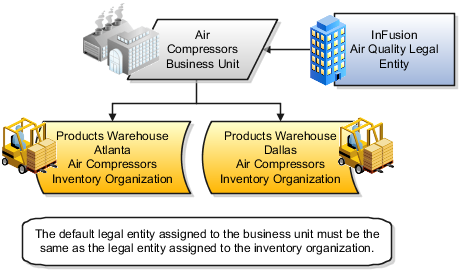11g Release 1 (11.1.3)
Part Number E22767-03
Contents
Previous
Next
|
Oracle® Fusion
Applications Cost Accounting and Receipt Accounting Implementation Guide 11g Release 1 (11.1.3) Part Number E22767-03 |
Contents |
Previous |
Next |
This chapter contains the following:
Inventory Organization: Critical Choices
In Oracle Fusion, storage facilities, warehouses, and distribution centers are implemented as inventory organizations.
Inventory organizations are:
Managed by a business unit, with the materials management business function enabled.
Mapped to a legal entity and a primary ledger.
There are two types of inventory organizations:
Manufacturing facilities
Storage facilities
Storage and manufacturing facilities are related to other organizational entities through a business unit that stores, manufactures, and distributes goods through many factories, warehouses, and distribution centers. The material parameters are set for both the facilities, enabling movement of material in the organization. This business unit has the business function of Materials Management enabled. Oracle Fusion Applications allow many inventory organizations to be assigned to one business unit.
Note
Currently, Oracle Fusion Applications do not include manufacturing capabilities, so setup your manufacturing facilities outside of Oracle Fusion applications.
A distribution center can store inventory that is the responsibility of different business units. In this situation, assign an inventory organization to each business unit as a representation of the inventory in the distribution center. The multiple inventory organizations representing the inventory are defined with the same location to show that they are a part of the same distribution center.
In the following figure the two business units, Air Compressors and Air Transmission, share one distribution center in Atlanta. The two inventory organizations, Air Compressors and Air Transmission represent the inventory for each business unit in the Atlanta distribution center and are both assigned the Atlanta location.

A legal entity owns the inventory located in a storage or manufacturing facility. This ownership is assigned through the relationship of the inventory organization representing the inventory and the legal entity assigned to the inventory organization. The legal entity assigned to the inventory organization shares the same primary ledger as the inventory organization's business unit.
The inventory is tracked in the inventory organization owned by the legal entity of which the business unit is part. All transactions are accounted for in the primary ledger of the legal entity that owns the inventory.
The figure below illustrates the inventory owned by InFusion Air Quality legal entity. The InFusion Air Quality legal entity is associated with the Air Compressors business unit, which is associated with the two Air Compressors inventory organizations. Therefore, InFusion Air Quality legal entity owns the entire inventory in both the Dallas and Atlanta locations.

A prerequisite to defining an inventory organization is to define a facility schedule. Oracle Fusion Applications allow you to associate an inventory organization with a schedule.
Facility schedules allow creating workday calendars for inventory organizations that are used in the Oracle Fusion Supply Chain Management product family. For example, use workday calendars in the scheduling of cycle counts and calculating transit time.